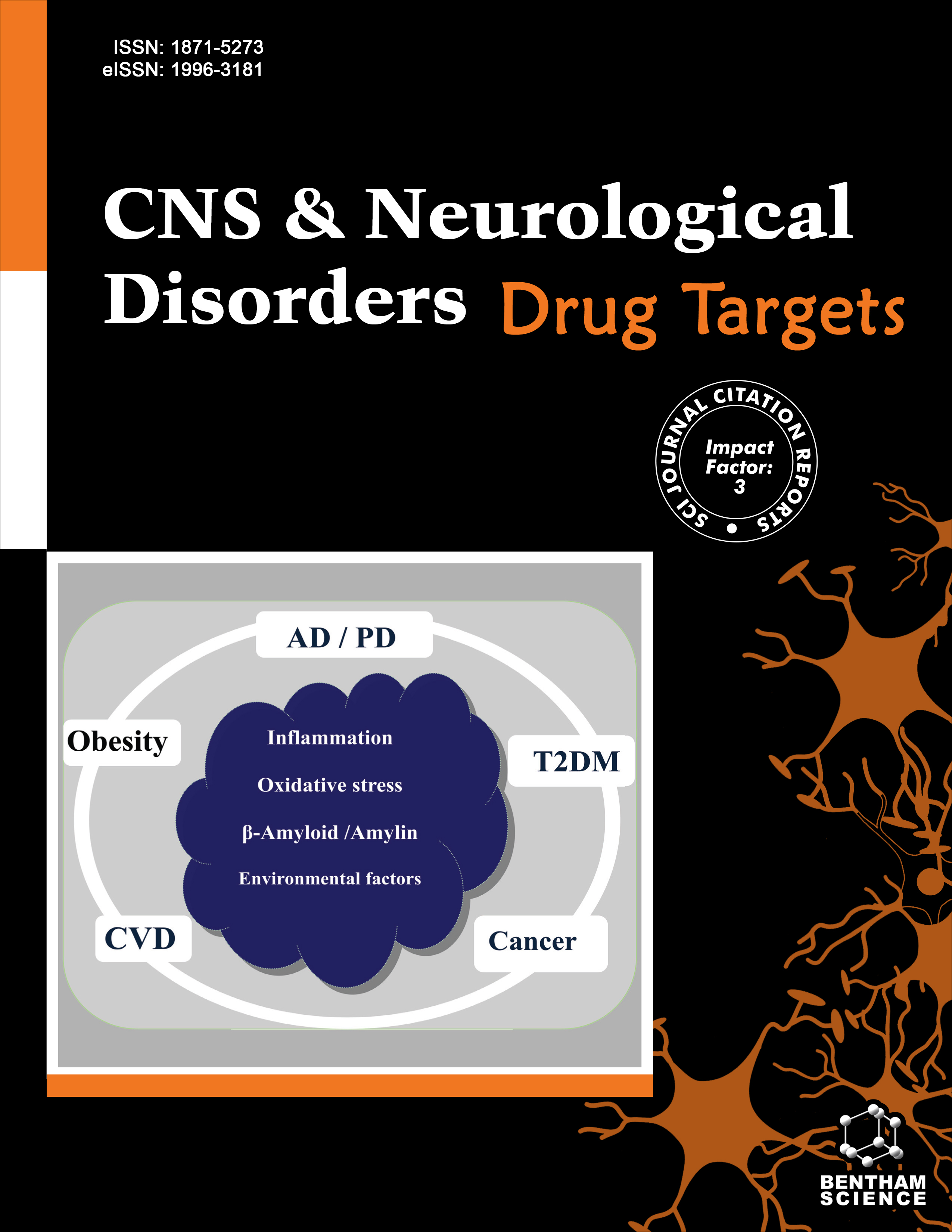- Home
- A-Z Publications
- CNS & Neurological Disorders - Drug Targets (Formerly Current Drug Targets - CNS & Neurological Disorders)
- Previous Issues
- Volume 23, Issue 2, 2024
CNS & Neurological Disorders - Drug Targets (Formerly Current Drug Targets - CNS & Neurological Disorders) - Volume 23, Issue 2, 2024
Volume 23, Issue 2, 2024
-
-
Choice and Timing of Antithrombotic after Ischemic Stroke, Intracerebral Hemorrhage or Cerebral Venous Thrombosis
More LessAuthors: Dylan Ryan, Tarun Girotra and Wuwei FengStroke is a multifactorial vascular disease and remains a leading cause of disability in the United States. Strokes can be ischemic or hemorrhagic in nature and secondary to arterial or venous disease, making determining the etiology and secondary prevention strategy important for preservation of the injured brain, prevention of recurrent strokes, and in the maintenance of good functional outcomes for patients impacted by strok Read More
-
-
-
Comprehensive Perspective Towards the Management of Proteinopathies by Elucidating Protein Misfolding and Aggregation
More LessAuthors: Ishfaq A. Ahanger, Ghulam Md. Ashraf, Anurag Sharma and Asimul IslamProtein misfolding and aggregation is the phenomenon of the generic propensity of proteins, considered as a dark side of the protein world, and its exact mechanism is still not deciphered. Understanding the complexity of protein aggregation is currently the primary apprehension and challenge in biology and medicine due to their association with various debilitating human proteinopathies and neurodegenerative diseases. The m Read More
-
-
-
Role of Animal Models in Parkinson's Disease (PD): What Role They Play in Preclinical Translational Research
More LessAuthors: Rajnish Srivastava, Hagera Dilnashin, Devesh Kapoor, Sai Aparna, Elmira Heidarli, Surya P. Singh and Vivek JainBackground: Animal models for drug discovery and development in Parkinson ’s disease have played an important role in the characterization of the pathophysiology of diseases and associated mechanisms of injury, drug target identification, and evaluation of novel therapeutic agents for toxicity/ safety, pharmacokinetics, pharmacodynamics, and efficacy. Objective: The review is intended to reform the scope, advantages, Read More
-
-
-
Bell Palsy: Facts and Current Research Perspectives
More LessBell palsy is a non-progressive neurological condition characterized by the acute onset of ipsilateral seventh cranial nerve paralysis. People who suffer from this type of facial paralysis develop a droop on one side of their face, or sometimes both. This condition is distinguished by a sudden onset of facial paralysis accompanied by clinical features such as mild fever, postauricular pain, dysgeusia, hyperacusis, facial changes, Read More
-
-
-
In-vivo and In-vitro Investigations to Assess Traumatic Brain Injury
More LessAuthors: Hemlata Bhardwaj, Neeru Vasudeva and Sunil SharmaTraumatic brain injury (TBI) is a major source of death and disability worldwide; however, its pathogenesis is no longer regarded as an immediate, irreversible process that occurs at the time of injury. Long-term alterations in personality, sensory-motor function, and cognition are common among trauma survivors. The pathophysiology of brain injury is very complex, so it is difficult to understand. Establishing models such as Read More
-
-
-
G Protein-coupled Receptors (GPCRs) as Potential Therapeutics for Psychiatric Disorders
More LessIn the central nervous system (CNS), G-protein-coupled receptors (GPCRs) are the most common targets of neuropharmacological drugs. GPCRs are activated by various neurotransmitters, which results in slow synaptic transmission. Recently, remarkable progress has been achieved in identifying genes and signaling pathways linked to the risk of psychiatric disorders. Even though the biological mechanisms governing ps Read More
-
-
-
Effect of Natural Plant Products on Alzheimer’s Disease
More LessAuthors: Himanshi Varshney and Yasir H. SiddiqueBackground: Plants and their extracts like ginger, garlic, Curcuma, Salvia, and Ginkgo are best known for their anti-oxidative and anti-inflammatory responses. These plants have shown their anti-Alzheimer’s properties in various in vivo and in vitro studies. Their diverse phytochemicals play a protective role against amyloid-beta-induced neurotoxicity and improve cognitive and learning impairments. These plants have a wide r Read More
-
-
-
New Psychometric Strategies for the Evaluation of Affective, Cognitive, and Psychosocial Functioning in Unipolar versus Bipolar Depression: Impact of Drug Treatment
More LessBackground: Different studies have been conducted to understand how patients with unipolar and bipolar depression differ in terms of cognitive and affective symptoms as well as in psychosocial function. Furthermore, the impact of antidepressants, second-generation antipsychotics, and mood stabilizers on these dimensions needs to be characterized, as well as the best psychometric approach to measure changes after p Read More
-
Volumes & issues
-
Volume 24 (2025)
-
Volume 23 (2024)
-
Volume 22 (2023)
-
Volume 21 (2022)
-
Volume 20 (2021)
-
Volume 19 (2020)
-
Volume 18 (2019)
-
Volume 17 (2018)
-
Volume 16 (2017)
-
Volume 15 (2016)
-
Volume 14 (2015)
-
Volume 13 (2014)
-
Volume 12 (2013)
-
Volume 11 (2012)
-
Volume 10 (2011)
-
Volume 9 (2010)
-
Volume 8 (2009)
-
Volume 7 (2008)
-
Volume 6 (2007)
-
Volume 5 (2006)
Most Read This Month
Article
content/journals/cnsnddt
Journal
10
5
false
en

Most Cited Most Cited RSS feed
-
-
A Retrospective, Multi-Center Cohort Study Evaluating the Severity- Related Effects of Cerebrolysin Treatment on Clinical Outcomes in Traumatic Brain Injury
Authors: Dafin F. Muresanu, Alexandru V. Ciurea, Radu M. Gorgan, Eva Gheorghita, Stefan I. Florian, Horatiu Stan, Alin Blaga, Nicolai Ianovici, Stefan M. Iencean, Dana Turliuc, Horia B. Davidescu, Cornel Mihalache, Felix M. Brehar, Anca . S. Mihaescu, Dinu C. Mardare, Aurelian Anghelescu, Carmen Chiparus, Magdalena Lapadat, Viorel Pruna, Dumitru Mohan, Constantin Costea, Daniel Costea, Claudiu Palade, Narcisa Bucur, Jesus Figueroa and Anton Alvarez
-
-
-
- More Less

